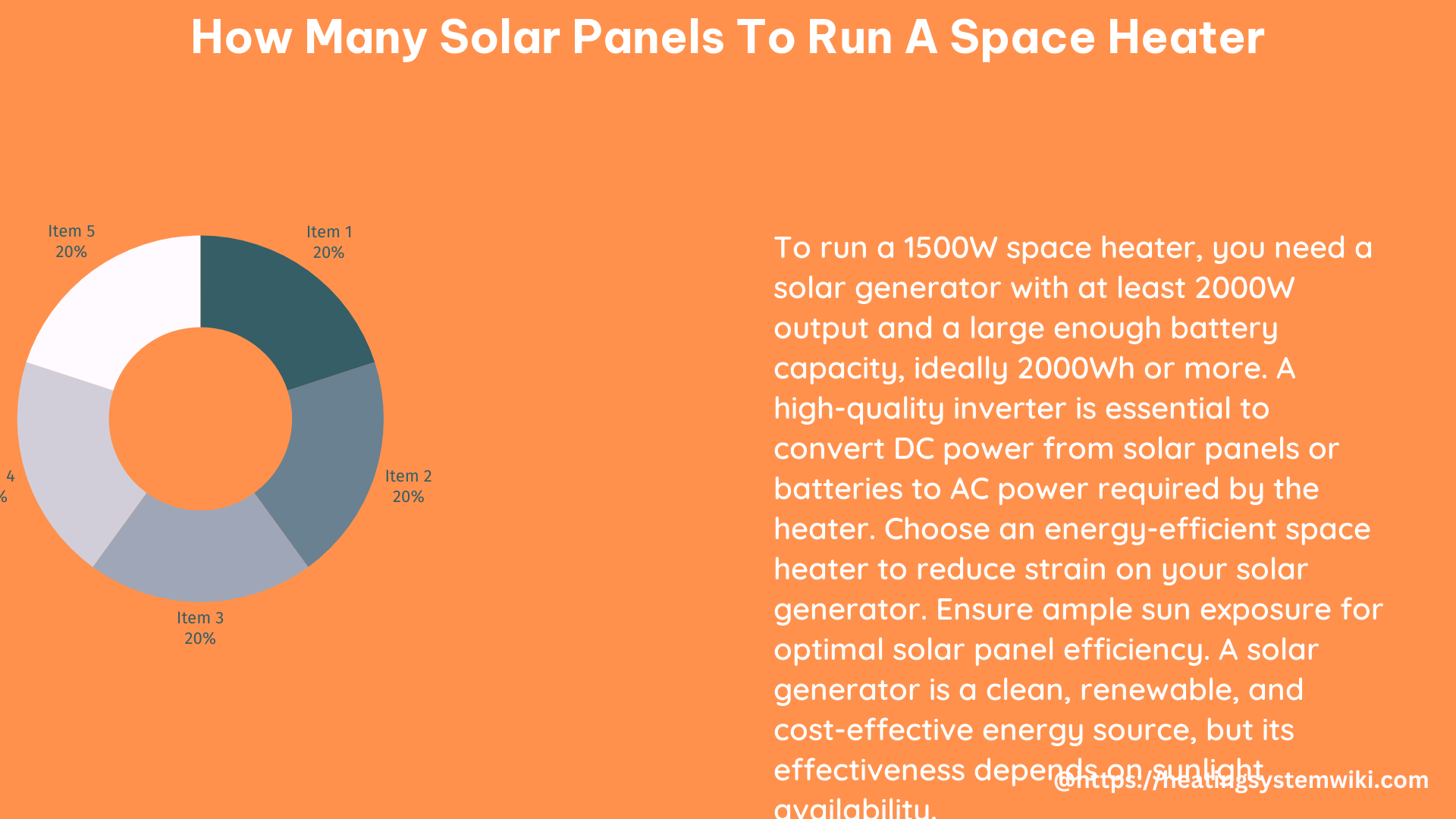To answer the question of how many solar panels are needed to run a space heater, we need to consider the wattage of the heater and the amount of energy it will consume over time. A 1500-watt heater, for example, would require at least 1500 watts of power from solar panels to operate. The number of solar panels needed depends on the wattage of the panels being used, the suitability of the home for solar panel installation, and the specific requirements of the space heater.
Calculating the Solar Panel Requirement for a Space Heater
The first step in determining the number of solar panels needed to run a space heater is to calculate the power requirement of the heater. Most space heaters range from 500 watts to 1500 watts, with 1500 watts being a common size for a medium-sized room.
To calculate the solar panel requirement, you can use the following formula:
Solar Panel Wattage Requirement = Space Heater Wattage
For example, if you have a 1500-watt space heater, you would need at least 1500 watts of solar panel capacity to power it.
Choosing the Right Solar Panels

Once you have determined the power requirement, you can choose the appropriate solar panels. The most common residential solar panels range from 250 watts to 400 watts per panel. To power a 1500-watt space heater, you would need a minimum of four 400-watt solar panels or five 300-watt solar panels.
It’s important to note that the actual number of solar panels required may vary depending on the efficiency of the panels, the amount of sunlight the panels receive, and the specific energy consumption of the space heater.
Here’s a table that shows the number of solar panels needed for different space heater wattages:
| Space Heater Wattage | 300-Watt Solar Panels | 400-Watt Solar Panels |
|---|---|---|
| 500 watts | 2 panels | 2 panels |
| 1000 watts | 4 panels | 3 panels |
| 1500 watts | 5 panels | 4 panels |
| 2000 watts | 7 panels | 5 panels |
Factors to Consider for Solar Panel Installation
When installing solar panels to power a space heater, there are several factors to consider:
-
Roof Orientation: The direction your roof faces can significantly impact the amount of sunlight the solar panels receive. Ideally, the panels should be oriented towards the south (in the northern hemisphere) or north (in the southern hemisphere) to maximize solar exposure.
-
Roof Pitch: The angle of your roof can also affect the solar panel’s efficiency. The optimal pitch for solar panels is typically between 15 and 45 degrees, depending on your latitude.
-
Shading: Ensure that the solar panels are not shaded by trees, buildings, or other obstructions, as this can reduce their energy output.
-
Battery Storage: Depending on your energy needs and the availability of sunlight, you may want to consider adding battery storage to your solar system. This can help ensure a consistent power supply for your space heater, even during periods of low sunlight.
-
Inverter Selection: The inverter is responsible for converting the DC power generated by the solar panels into AC power that can be used by your space heater. Choose an inverter that is compatible with your solar panel setup and can handle the power requirements of your space heater.
DIY Solar Panel Installation for Space Heaters
For smaller space heaters, it is possible to set up a DIY solar panel system. This can be a cost-effective solution, especially for off-grid or remote locations. Here are some tips for a DIY solar panel installation for a space heater:
-
Choose a 12V DC Space Heater: Look for a space heater that is designed to run on 12V DC power, as this will simplify the installation process.
-
Select a 100-Watt Solar Panel: A single 100-watt solar panel can be sufficient to power a small 12V DC space heater, provided that the heater’s power consumption is within the panel’s capacity.
-
Include a Battery Bank: Incorporate a battery bank to store the solar-generated power, ensuring a consistent power supply for your space heater, even during periods of low sunlight.
-
Use the Correct Wiring and Connections: Ensure that the wiring and connections between the solar panel, battery bank, and space heater are properly sized and secured to prevent any safety issues.
-
Monitor the System: Regularly check the performance of your DIY solar panel system to ensure that it is operating efficiently and meeting the power requirements of your space heater.
Remember, while a DIY solar panel installation for a space heater can be a viable option, it’s essential to follow all safety guidelines and local regulations to ensure a safe and compliant setup.
Conclusion
Determining the number of solar panels needed to run a space heater requires careful consideration of the heater’s power consumption, the solar panel’s wattage, and the specific installation requirements. By following the guidelines and calculations provided in this comprehensive guide, you can ensure that your solar panel system is properly sized to meet the energy demands of your space heater, whether it’s a large 1500-watt unit or a smaller DIY setup.
Remember to always prioritize safety, consult with professionals when necessary, and stay up-to-date with the latest advancements in solar technology to optimize your energy-efficient heating solution.
